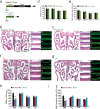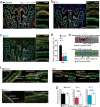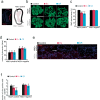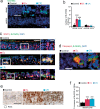Dorsal-zone-specific reduction of sensory neuron density in the olfactory epithelium following long-term exercise or caloric restriction
- PMID: 30470811
- PMCID: PMC6251928
- DOI: 10.1038/s41598-018-35607-w
Dorsal-zone-specific reduction of sensory neuron density in the olfactory epithelium following long-term exercise or caloric restriction
Abstract
Exercise (Ex) and caloric restriction (CR) reduce oxidative stress and improve organ function. For instance, voluntary Ex or CR is known to reduce age-related cochlear damage in male C57BL/6J mice. However, the effect of Ex and CR on the olfactory system is unknown. In this study, we confirmed the positive effect of Ex and CR on age-related cochlear damage, but found that Ex and CR affected negatively cell dynamics in the olfactory epithelium (OE) by reducing the number of mature olfactory sensory neurons (OSNs) and increasing the number of proliferative basal cells and apoptotic OSNs in the dorsal zone of the olfactory epithelium (OE), which contains neurons expressing NADPH quinone oxido-reductase 1 (NQO1). In addition, these interventions resulted in lower odor-induced c-fos expression in areas of the olfactory bulb receiving projections from dorsal-zone OSNs than in areas receiving ventral-zone projections. Further, we observed substantial oxidative stress in NQO1-positive cells and apoptotic OSNs in the dorsal zone in Ex and CR animals. These results suggest that, in contrast to their positive effects in other organs, Ex and CR facilitate oxidative stress and negatively impact structure and function in dorsal-zone OSNs, probably in association with NQO1 bioactivation.
Conflict of interest statement
The authors declare no competing interests.
Figures









Similar articles
-
Zone-specific damage of the olfactory epithelium under protein restriction.Sci Rep. 2020 Dec 17;10(1):22175. doi: 10.1038/s41598-020-79249-3. Sci Rep. 2020. PMID: 33335225 Free PMC article.
-
NQO1 activity in the main and the accessory olfactory systems correlates with the zonal topography of projection maps.Eur J Neurosci. 2004 May;19(9):2511-8. doi: 10.1111/j.0953-816X.2004.03331.x. Eur J Neurosci. 2004. PMID: 15128404
-
Sensory deprivation disrupts homeostatic regeneration of newly generated olfactory sensory neurons after injury in adult mice.J Neurosci. 2015 Feb 11;35(6):2657-73. doi: 10.1523/JNEUROSCI.2484-14.2015. J Neurosci. 2015. PMID: 25673857 Free PMC article.
-
Structures and functions of the normal and injured human olfactory epithelium.Front Neural Circuits. 2024 Jun 6;18:1406218. doi: 10.3389/fncir.2024.1406218. eCollection 2024. Front Neural Circuits. 2024. PMID: 38903957 Free PMC article. Review.
-
Apoptosis in the mature and developing olfactory neuroepithelium.Microsc Res Tech. 2002 Aug 1;58(3):204-15. doi: 10.1002/jemt.10150. Microsc Res Tech. 2002. PMID: 12203699 Review.
Cited by
-
Examining the role of olfaction in dietary choice.Cell Rep. 2021 Feb 16;34(7):108755. doi: 10.1016/j.celrep.2021.108755. Cell Rep. 2021. PMID: 33596417 Free PMC article.
-
Evidence for the spread of SARS-CoV-2 and olfactory cell lineage impairment in close-contact infection Syrian hamster models.Front Cell Infect Microbiol. 2022 Oct 21;12:1019723. doi: 10.3389/fcimb.2022.1019723. eCollection 2022. Front Cell Infect Microbiol. 2022. PMID: 36339331 Free PMC article.
-
SARS-CoV-2 Receptors and Entry Genes Are Expressed in the Human Olfactory Neuroepithelium and Brain.iScience. 2020 Dec 18;23(12):101839. doi: 10.1016/j.isci.2020.101839. Epub 2020 Nov 25. iScience. 2020. PMID: 33251489 Free PMC article.
-
Oral SARS-CoV-2 Inoculation Causes Nasal Viral Infection Leading to Olfactory Bulb Infection: An Experimental Study.Front Cell Infect Microbiol. 2022 Jun 13;12:924725. doi: 10.3389/fcimb.2022.924725. eCollection 2022. Front Cell Infect Microbiol. 2022. PMID: 35770069 Free PMC article.
-
Prolonged and extended impacts of SARS-CoV-2 on the olfactory neurocircuit.Sci Rep. 2022 Apr 6;12(1):5728. doi: 10.1038/s41598-022-09731-7. Sci Rep. 2022. PMID: 35388072 Free PMC article.
References
-
- Kim JD, McCarter RJ, Yu BP. Influence of age, exercise, and dietary restriction on oxidative stress in rats. Aging (Milan, Italy) 1996;8:123–129. - PubMed
Publication types
MeSH terms
Substances
LinkOut - more resources
Full Text Sources
Miscellaneous

